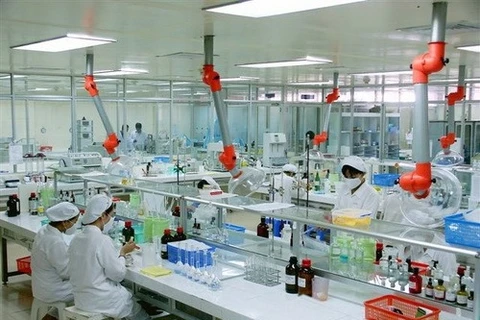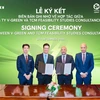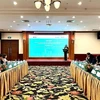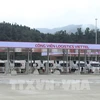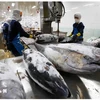HCM City (VNS/VNA) - With an emerging market economy and continued strong growth, Vietnam is set to become one of the most dynamic markets in the world by 2030, according to Euromonitor International, a global market research company.
An Hodgson, Euromonitor International’s income and expenditure research manager, said the company’s research database showed that urbanisation, with the associated concentration of income, wealth and population, would propel Vietnam’s commercial success by 2030.
Published last month, the research database has found that Vietnam will be the third biggest urban market by consumer numbers and fifth biggest by total spending in Southeast Asia.
By 2030, the country’s urban consumer market will expand to 46 million consumers and 169 billion USD worth of spending.
GDP growth is expected to reach 91.4 percent in the 2019-2030 period and disposable income to 9,740 USD per household by 2030.
There will be 17 million middle class households in 2030, according to the company’s research.
The burgeoning middle class in Vietnam will drive consumer spending growth as well as give rise to new consumer trends by 2030.
“One in two households will be middle class by 2030,” she said. “The essence of a middle-class consumer is the ability to spend on discretionary items.”
Representing an increase of 34 percent from 2018, Vietnamese middle-class consumers are “aspirational, brand-aware and price-conscious”.
Rural consumers also remain important. In 2030, rural residents, which number 61 million, are expected to spend a total of 173 billion USD.
There are gaps between the products and services that are currently available and those that older consumers actually want and need.
According to Euromonitor, the fastest-growing population segment is 70 to 79 years old.
By 2030, 12.4 percent of the Vietnamese population will be aged 65 and above, which equates to a market size of 13 million elderly consumers.
The over-65 segment is the third lowest-earning age group, with an average gross income of 57 million VND (2,560 USD) in 2018.
However, their real purchasing power is set to grow the fastest of all age groups up to 2030.
“Older consumers feel, behave and want to be treated as younger people are. They want branding to focus more on needs, interests and values that include consumer experience, convenience, authenticity and novelty,” Hodgson said.
“Businesses that adopt more universal strategies rather than applying age labels can effectively win ageing consumers, while also appealing to younger consumers,” she added.
In 2030, Vietnam is expected to be the fifth largest economy in Southeast Asia where 50 percent of the households will have an annual disposable income of 5,000 USD to 15,000 USD.
Although the population is price-sensitive, consumers are willing to pay higher prices for branded products deemed to be healthier or better-quality.
In addition, according to Euromonitor, internet retailing is set to double its market size and reach 5 billion USD by 2023. While online shopping is not yet prevalent in Vietnam, brands and retailers should stay ahead of e-commerce.
The conference also discussed major global consumer trends and their impact in Vietnam and Southeast Asia.
According to Euromonitor, Vietnam and the Southeast Asia region remain the key focus of global business developments due to healthy economic growth.
The conference provided insights on how companies could tap into the Vietnamese market.
Euromonitor International is the world’s leading provider for global business intelligence and strategic market analysis. During the last 40 years, it has been publishing international market reports, business reference books and online databases on consumer markets.-VNS/VNA
An Hodgson, Euromonitor International’s income and expenditure research manager, said the company’s research database showed that urbanisation, with the associated concentration of income, wealth and population, would propel Vietnam’s commercial success by 2030.
Published last month, the research database has found that Vietnam will be the third biggest urban market by consumer numbers and fifth biggest by total spending in Southeast Asia.
By 2030, the country’s urban consumer market will expand to 46 million consumers and 169 billion USD worth of spending.
GDP growth is expected to reach 91.4 percent in the 2019-2030 period and disposable income to 9,740 USD per household by 2030.
There will be 17 million middle class households in 2030, according to the company’s research.
The burgeoning middle class in Vietnam will drive consumer spending growth as well as give rise to new consumer trends by 2030.
“One in two households will be middle class by 2030,” she said. “The essence of a middle-class consumer is the ability to spend on discretionary items.”
Representing an increase of 34 percent from 2018, Vietnamese middle-class consumers are “aspirational, brand-aware and price-conscious”.
Rural consumers also remain important. In 2030, rural residents, which number 61 million, are expected to spend a total of 173 billion USD.
There are gaps between the products and services that are currently available and those that older consumers actually want and need.
According to Euromonitor, the fastest-growing population segment is 70 to 79 years old.
By 2030, 12.4 percent of the Vietnamese population will be aged 65 and above, which equates to a market size of 13 million elderly consumers.
The over-65 segment is the third lowest-earning age group, with an average gross income of 57 million VND (2,560 USD) in 2018.
However, their real purchasing power is set to grow the fastest of all age groups up to 2030.
“Older consumers feel, behave and want to be treated as younger people are. They want branding to focus more on needs, interests and values that include consumer experience, convenience, authenticity and novelty,” Hodgson said.
“Businesses that adopt more universal strategies rather than applying age labels can effectively win ageing consumers, while also appealing to younger consumers,” she added.
In 2030, Vietnam is expected to be the fifth largest economy in Southeast Asia where 50 percent of the households will have an annual disposable income of 5,000 USD to 15,000 USD.
Although the population is price-sensitive, consumers are willing to pay higher prices for branded products deemed to be healthier or better-quality.
In addition, according to Euromonitor, internet retailing is set to double its market size and reach 5 billion USD by 2023. While online shopping is not yet prevalent in Vietnam, brands and retailers should stay ahead of e-commerce.
The conference also discussed major global consumer trends and their impact in Vietnam and Southeast Asia.
According to Euromonitor, Vietnam and the Southeast Asia region remain the key focus of global business developments due to healthy economic growth.
The conference provided insights on how companies could tap into the Vietnamese market.
Euromonitor International is the world’s leading provider for global business intelligence and strategic market analysis. During the last 40 years, it has been publishing international market reports, business reference books and online databases on consumer markets.-VNS/VNA
VNA


